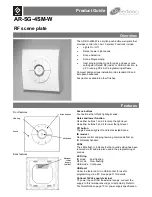
Advanced Settings
Notes:
(1) After making the adjustment the reading will
immediately change. Allow time for the
temperature to stabilise at T
2
before making any
further adjustment. At this point, a
ZEro
adjustment may be needed, refer to step 1
above.
(2) Check that the temperature correctly stabilises at
T
2
and then adjust setpoints to T
1
. If an error is
present at T
1
repeat from step 2.
LINEAR INPUT CALIBRATION
In addition to the ten temperature inputs, the controller has
five linear input ranges which can be calibrated to display a
range of engineering units. This procedure involves making
adjustments to the controller’s
HI.SC
,
ZERO
and
SPAN
adjustments found in function menu levels 2
and 3.
Note:
The controllers linear inputs are in mV. If your
transducer provides an output in mA this should
be converted to mV by feeding the controller input
via a high stability one ohm resistor, see figure page 26.
Other low Vdc signals can be connected via a
suitable voltage divider network to match the
controller input requirements.
Calibration to Another Instrument (continued)
2
Adjust using the
SPAN
function
2.1 Chose a temperature near the bottom and
another near the top of the scale.
2.2 Run the process at the lower temperature (
T
1
).
Note the error (
E
1
) between the controller and the
instrument readings.
2.3 Repeat at the upper temperature (
T
2
) and note
error (
E
2
).
2.4 Substitute the values for T
1
, T
2
, E
1
and E
2
in the
expression below to calculate
SPAN
E
2
-E
1
X
hi.SC
=
SPAn
T
2
-T
1
For
hi.SC
settings see level 2.
Example:
T
1
T
2
Instrument reading
58°
385°
Controller reading
60°
400°
Error
E
1
(-) 2°
E
2
(-) 15°
(-15) - (-2) x 450 = (-13) x 450 = (-)17.9
385 - 58 327
2.5 Therefore adjust
SPAn
to (-) 18 to correct error.
25










































